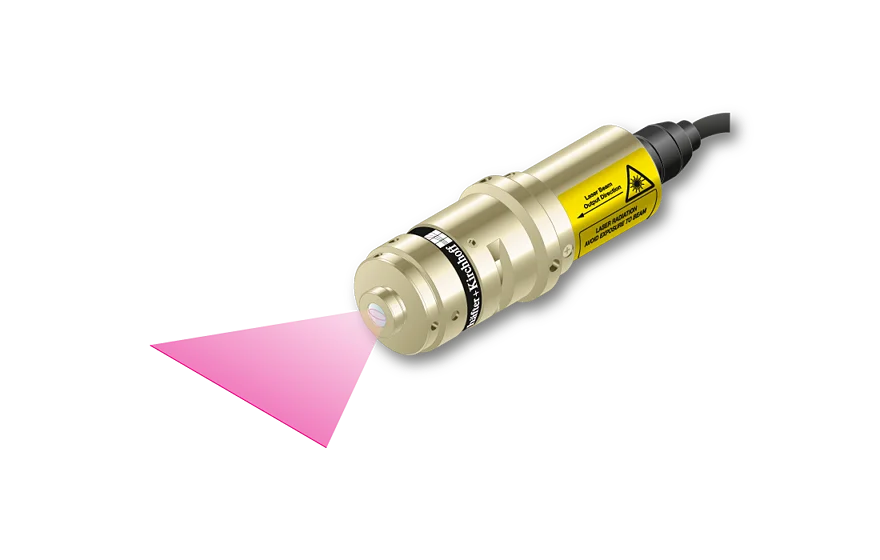Features
- Line widths starting at 26 µm
- Wavelengths 405 - 940 nm
- Laser powers up to 108 mW
- Discontinued
Laser Micro Line Generator with a large fan angle


This product has been discontinued. Requests will be managed according to the residual stock. Contact us to discuss any specific need.
The laser diode beam source series 5LP produces laser lines with a fan angle of about 40°, 62°, or 84°. The intensity profile is Gaussian in line direction clipped by an aperture with an edge intensity of typ. 30%. The line width is constant along the laser line. Across the laser line the intensity distribution is Gaussian.
Laser Micro Line Generators designed to produce lines with small line width. They have a small depth of focus (in this case the depth of focus is the Rayleigh range). Laser Macro Line Generators like the corresponding lasers of series 5LPM have common basic optical features but are designed to generate laser lines with an extended depth of focus.
The laser has integrated electronics for control of the laser output power. The output power can be controlled using the modulation input ports (TTL and analog) or manually using the potentiometer. Optionally the lasers can be equipped with RS232 serial interface for laser control and data read-out.
For this laser type the working distance is fixed. A fine-adjustment of the distance between laser and target is recommended for fine-focusing in order to achieve minimal line width.
These high quality lasers can e.g. be used for machine vision applications, laser triangulation or laser light sectioning.
This product has been discontinued. Requests will be managed according to the residual stock. Contact us to discuss any specific need.
What does Micro or Macro Laser mean?
Features of Laser Modules with RS232 interface
Line geometry, intensity distribution, definition of line length and working distance, definition of line width and machine vision applications.
Fan angle vs. semi-telecentric.
Gaussian intensity distribution and uniform intensity distribution along the laser line
Line length and working distance definition
Line width definition
When do they appear and how to prevent them
What wavelengths are available for diode based laser modules?
Straight and angled cable exit
Laser triangulation, laser light sectioning, particle measurement etc.
Laser diode based laser sources for high precision measurement and inspection systems
This product has been discontinued. Requests will be managed according to the residual stock. Contact us to discuss any specific need.
The laser has integrated electronics for control of the laser output power. The output power can be controlled using the modulation input ports TTL and analog (TTL only for electronics type B) or manually using the potentiometer.
Using the potentiometer you set the maximum output power of the laser. Turn the potentiometer clockwise for more power and anti-clockwise for lower power.
For all lasers with analog modulation input: The input for analog modulation allows applying an analog voltage Uanalog, which allows a linear control of the laser output power from approximately zero up to the maximum power given by the potentiometer setting.
Please refer to the manual for more details.
No, you are not allowed to take off the attachment optics. If you do so you can severely damage the laser as well as hurt yourself and others around you.
Each modification of the laser needs to be discussed with Schäfter+Kirchhoff first and is not to be done by the customer.
Often higher power lasers can be equipped with internal optical filters to reduce the laser power, which in consequence may mean a smaller laser class.
This option has the advantage, that you can still set the laser power using the potentiometer and - if the laser has an analog modulation input- use the full range of the analog modulation input for setting the laser power.
Please note, that reducing the laser power by potentiometer or analog modulation input so that it operates close to the laser threshhold negatively affects laser features like pointing stability, line width/spot size or state of polarization.
Please contact Schäfter+Kirchhoff for lasers with reduced laser power.
This product has been discontinued. Requests will be managed according to the residual stock. Contact us to discuss any specific need.
This product has been discontinued. Requests will be managed according to the residual stock. Contact us to discuss any specific need.